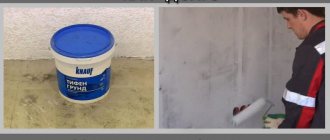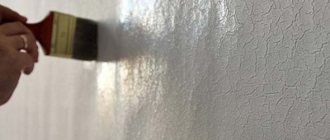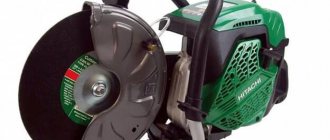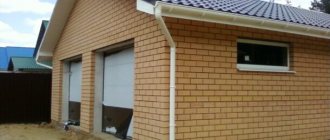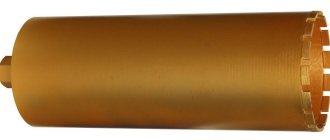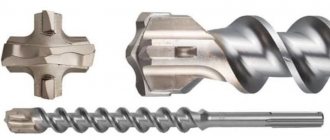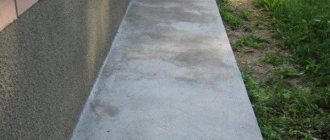To impregnate brick and concrete walls before subsequent finishing, special primer coatings are needed, for example, deep penetration acrylic primers for concrete. Penetrating inside the enclosing structure, the polymer creates an adhesive layer capable of holding paint. Wallpaper glue interacts with primers, a strong bond is formed, which strengthens as the adhesive component dries.
The market offers a wide range of materials that help prepare concrete for finishing work. The user is not always able to navigate the available offers. Therefore, a rating of compositions for application to porous surfaces before final finishing has been compiled.
Scope of application
Walls made of stone or other piece goods have a porous structure. There are capillaries, the polymer composition penetrates into them. Read about façade putty for exterior use here.
During polymerization, an elastic system is formed that is securely fixed to the surface.
When dry, the primer creates an analogue of a spatial grid. This occurs due to the fact that it is not simultaneous removal of moisture, but batch evaporation. As a result, gaps are created between individual fragments. When examining the structure under a microscope, it was established:
- When a porous substance is filled with polymer, there is no continuous coating. Part penetrates into the thickness of the material being processed, the remaining elastic liquid material remains outside;
- As it dries, microscopic tears form at penetration points. Zones arise where the liquid part remains. The dried polymer looks like a fishing net;
- upon final polymerization, the coating becomes sponge-like. It contains capillaries into which paint or glue penetrates during subsequent finishing;
- The strength of the sponge body is so high that it can hold a distributed load weighing up to 90...100 g per square meter on a brick surface. Indicators on a concrete surface are slightly higher, up to 120...140 g/m².
Manufacturers of primer mixtures indicate:
- the primer film on a plastered wall can reach a thickness of 0.20...0.35 mm. Holding capacity increases to 110…150 g/m²;
- plasterboard structures coated with a layer of 1.0...1.5 mm of gypsum-based putty, after puttingtying the plasterboard under the wallpaper, the primer can hold the wallpaper with an applied adhesive weighing 100...135 g/m²;
- a brick wall with smoothed seams can carry wallpaper weighing 45...55 g/m²; after coating with a polymer solution, the load-bearing capacity increases to 85...90 g/m²;
- the enclosing structure, made of gas blocks connected with an adhesive solution, holds up to 95...110 g/m²;
- foam concrete blocks are capable of holding paint coatings weighing more than 95 g/m².
Pre-impregnation improves the conditions for adhesion of the base to finishing materials.
Price
The cost directly depends on the purpose, density and volume purchased. For example, a primer with the addition of quartz is expensive because expensive raw materials are used. We are talking about concrete contact, where for 200 grams of raw materials you will have to pay about 100 rubles.
Birss primer is universal, with a consumption of up to 230 g. per square meter, with a capacity of 10 kg, will cost about 500 rubles. It is profitable to buy in such a volume, since it will last a lot. The composition includes latex filler, which allows you to fill pores and remove dust from the surface.
Primer for concrete Ceresit ST17
In addition, the water-dispersion base is completely safe for indoor use. Water-dispersion primer is suitable for treating walls, floors, ceilings, and other concrete-based surfaces.
There is a deep absorption composition on sale, for example, Neolab. For a container of 5 liters you will have to pay around 200 rubles. The strengthening composition for the concrete floor “AK-02” Grid, weighing 27 kg, in a metal container, costs about 3,500 rubles.
Types of deep penetration acrylic putties for concrete
There is no debate between professionals performing finishing work about which primer is best. Everyone develops their own preferences over time. In many ways, they depend not only on the brand under which a particular manufacturer markets its product. Other indicators often work here. Finishers note their ways of assessing quality:
- drying speed. Some people like it to cure quickly. Others believe that with a long process, the depth of penetration into the porous medium increases. The structure becomes looser. It is able to create stronger adhesive bonds;
- material consumption. This criterion can be assessed in different ways. Low consumption creates only a surface film. Its strength may be low. With increased consumption, the strength characteristics will be much higher.
Home craftsmen with no experience who have to do repair work rely on advertising in the media. Sometimes the choice depends on the type of labels on the container. The brighter it is, the more it attracts the eye of a potential buyer on the store shelf. Read about glue for gas silicate blocks here.
Based on numerous checks, the indicators presented in table were generated. 1.
Table 1: Indicators of deep penetration primer mixtures
| Indicators | Units | Numerical values |
| Primer consumption | g/m² | 60…280 |
| Acid-base characteristics, pH | – | 7,2…8,2 |
| Penetration depth on porous building materials | mm | 4,5…8,5 |
| Duration of polymerization | hour | 1,5…6,5 |
| Recommended temperature conditions for primer operation | °C | +5…+35 |
| Macrometric particle size in a colloidal solution | µm | 30…70 |
Primer or impregnation for concrete floors
Such structures are distinguished by high strength. It has been experimentally proven that the given strength indicators exceed the characteristics of alloy steels (more than 120...150 MPa for tensile or compression, for steels this indicator is no more than 25...28 MPa). The actual thickness of the formed threads inside the structure is measured in microns and is no more than 12...20 microns. Therefore, the actual breaking force is lower. Knauf will tell you about putty in this material.
A primer is a polymer that can form long molecules upon polymerization.
Polymer-based impregnation forms a three-dimensional structure of intertwined threads, which can improve the adhesive properties of paint coatings or glue. At the same time, the impregnations do not completely clog the capillaries. The walls are able to maintain air exchange. About such coatings. They are said to "breathe".
Price – 2,178 rub.
Sealants for outdoor surfaces and joints
A distinctive feature of sealants is that when they are applied to any surface, films are created in which there are no penetrating holes or capillaries. Sealed covering materials are designed to prevent moisture from penetrating into walls. Therefore, they are used as protection against various methods of moisturizing. Read about tile adhesive for exterior use at this link.
Such primers are necessary for exterior painting of walls. They are often used when treating basements.
Some users are confused and recommend using acrylic sealants in exterior finishing where the moisture pressure is quite high. The low price is attractive. But it should be remembered that with sudden temperature changes (observed in enclosing structures), films can withstand a relatively small number of freezing and thawing cycles. Recommended for use only for interior decoration
Acrylic sealants are water-based (they can be loosened by adding water if necessary). After polymerization, they can be coated with enamels (based on oils or alcohols). They penetrate inside and are securely fixed, and durable glossy films are formed on the surface.
stain
Stains are understood as liquid compounds that can enhance the internal texture pattern. When applied to concrete impregnations, stains are created on a silicone basis. Such films, after polymerization in the open air, retain elasticity for ten to twenty years (even with repeated transitions through 0 ° C). The resulting sealed film withstands the pressure not only of water, but also of freezing ice, which, when freezing, can create external pressure of up to 200 MPa (about 2000 kg/cm²). Find out how to calculate putty consumption per 1m2 of drywall in this article.
Price per piece – 69 rub.
The presence of such material on the surface does not allow moisture to penetrate inside, causing a destructive effect.
Varnish
Varnishes are rarely used as part of impregnations. The explanation is quite simple: the price of acrylic or silicone varnish reaches over 700 rubles. for 1 liter of mixture. When dry, a rather thin film forms.
Some manufacturers (Wet Stone, Element and Orion) are increasing the price of their products, hoping to create not only a primer, but a higher quality material that can perform decorative functions.
Enamel
Enamels include fairly thick coating layers. They are able to protect against atmospheric influences, as well as mechanical contact between individual parts during operation. When applied to wall protective materials, enamels protect the surface from impact and abrasion.
Acrylic enamels are made on the basis of water dispersions. Their polymerization is accompanied by the release of water vapor and a small amount of carbon dioxide. The released substances are classified as non-toxic components. Therefore, it is allowed to be used in residential areas, as well as where children are located.
Cost – 2,800 rubles.
A distinctive feature of acrylic-based enamels is their resistance to solar radiation. They do not lose color saturation during prolonged use in sunlit areas.
Concrete contact
Among the impregnations there are those that do not require preliminary removal of the old coating. The labor intensity of preparatory work is reduced. It is necessary to cover the surfaces to be finished with concrete contact.
This treatment is sufficient to retain up to 150 g/m² of new finishing material. When the concrete contact dries, a loose, permeable film up to 1.5...1.8 mm thick is formed. It fits the outside of the treated surface, like a strong mesh.
Some analogues are capable of working for a long time under the influence of low temperatures, so they are offered for holding not only paints and varnishes. Plaster mortars up to 5...7 mm thick can be placed on the surface of the impregnation, which bears the inscription “concrete-contact”.
The soil contains binders, as well as marble chips or quartz sand.
For outdoor use
Primers used on facades have higher strength properties compared to materials intended for interior decoration. They have:
- plastic properties are maintained over a wide temperature range;
- can withstand multiple transitions through 0 °C;
- resist the effects of ultraviolet radiation.
Price – from 350 rub.
Primers are often materials similar to finishing putties. The layer thickness reaches up to 1.0...3.5 mm. The surface can withstand not only static loading. Some also withstand shock loads.
Why is it important to treat the concrete surface with soil?
Many people mistakenly believe that protecting a concrete foundation is not necessary.
However, despite the fact that concrete itself is a very durable material with a long service life, it is also susceptible to various aggressive environments and loads.
- Water entering through the pores, freezing, can lead to delamination of the material and the appearance of microcracks.
- The reinforcement present in the concrete body begins to rust under the influence of water, gas, and salts, which also gradually leads to destruction.
Destruction of concrete from corrosion
- If we talk about concrete floors, then the top layer of the base is quite fragile, during operation it begins to deteriorate, dust appears, which harms human health and worsens the characteristics of the floor.
What does priming a concrete surface provide:
- The soil binds dust particles and the surface is dust-free.
- A primer for concrete surfaces protects the base from the formation of fungus and mold.
- With the help of such compositions, the adhesion of a smooth concrete base to subsequently applied coatings is improved. Otherwise, after finishing work, cracks may appear in the plaster and paint, and the wallpaper may peel off.
- As a result of using a primer, the quality of application is improved and the consumption of liquid and paste finishing materials is reduced.
- Primers close the pores of concrete, thereby protecting it from external influences and increasing its service life.
- The use of soil allows you to strengthen the top layer of concrete and make it more resistant to loads.
Considering the above, we can conclude that treating the floor, walls, ceiling, and other concrete bases with a primer is necessary. Requirements for materials for protecting concrete are set out in GOST 31384-2008 “Protection of concrete and reinforced concrete structures from corrosion.”
TOP 5 best primers
What is it advisable to pay attention to when it becomes necessary to purchase finishing materials, as well as primers to prepare walls for painting or finishing with paper or non-woven wallpaper?
Prospectors
The products of the company Prospectors are known to users from Russia. The company has been producing materials for finishing work since 1992. Ready-to-use products are packaged in plastic containers. The indicators of working mixtures are presented in table. 2.
Table 2: Indicators of primer components from
| Indicators | Units | Numerical values |
| Consumption of primer coating on concrete walls | g/m² | 90…180 |
| Acid-base characteristics, pH | – | 7,2…7,5 |
| Penetration depth on porous building materials | mm | 2,0…4,5 |
| Duration of polymerization | hour | 0,8…1,2 |
| Recommended temperature conditions for primer operation | °C | +5…+40 |
| Presence of latex in the structure | % | 30…35 |
When using a putty mixture, some craftsmen add quartz sand. They claim that the slight increase in drying time is compensated by the higher strength characteristics of the compositions used.
Safety precautions
According to labor safety standards, when working with primer compositions, it is necessary to prevent the working compositions from getting on the skin, eyes, mucous membranes, or inside the body.
Personal protective equipment is used during primer treatment.
If the working mixture accidentally gets on the skin, quickly wipe it with a clean rag and wash with running water and soap. In case of contact with mucous membranes, consult a doctor immediately.
It must be remembered that fire safety standards must be observed at the facility . When mixing primers, the presence of open flames and ignition sources is unacceptable. The tool used should not produce a spark when struck.
Workers must undergo preliminary training, training in safe work skills, and a medical examination. Concrete work is carried out using scaffolding (scaffolding, scaffolding). The processing area is fenced.
Ceresit
The company has been on the market since 1898. Among its developments are adhesives for heated floors and bitumen-based impregnations. Houses using similar impregnations for finishing still exist today. Cement-based waterproofing impregnations have been produced since 1908 to the present day. The relevance of their use is only increasing.
Price – 450 rub.
Interior primers provide nearly double the adhesion of the original materials. Facade primer mixtures are used in construction at the cold pole (in the cities of Oymyakon and Verkhoyansk).
Optimist
Russian manufacturer specializing in the production of acrylic-based primers. They are used in interior and facade decoration. Users note that pre-impregnation with compositions from Optimist helps to fearlessly stick heavy non-woven wallpaper on walls made of brick and other wall materials.
Bolars
The product range is quite wide. When carrying out repair work, professionals try to purchase not only impregnations from Bolars. All types of finishing materials interact perfectly with each other, complementing each other.
The primer composition from Bolars is presented in the form of a colloidal solution with a slightly whitish tint. It is recommended to use it not only for concrete walls. Excellent performance is observed when used for finishing plasterboard sheets. Films up to 0.5 mm thick are formed that hold heavy varnishes and paints, as well as wallpaper and fiberglass.
Cost – 439 rubles.
Tex
Concrete contact mortars are used to repair buildings. Products from Tex are used for preparatory work. Tex putty and primer mixtures have high adhesion. The latest developments are used in production. Therefore, many finishers speak quite warmly about the products.
Professionals note that this material takes a little longer to dry than from other manufacturers. But when wallpapering on drywall without putty, on a primer, conditions are created for deep penetration of adhesive and coloring materials. The wear resistance of the finishing coating is high.
How to use it correctly?
There are three ways to apply the primer. This is done with a brush, roller, or sprayer. All this is indicated on the container with soil, since everything depends on the density and, if applied in an inappropriate way, there is a possibility of clogging the holes of the sprayer.
Most people work with a roller, pouring the soil into a container special for this purpose. This way you can do the job faster and saturate the base properly. In addition, the roller is quite economical, since almost nothing is spilled on the floor.
The brush will have to work in hard-to-reach places, such as the corners of walls and ceilings, near obstacles and other places. In this case, deep penetration concrete contact with quartz sand is more convenient to apply with a brush. It is expensive and is mainly used zonally, so when working with a brush, it is more convenient not to go beyond the limits.
The process of applying primer to concrete
Any soil is already supplied ready-made. Therefore, it is enough to deliver it, shake it, open the lid, pour it into a container convenient for use and use it for its intended purpose. There is no need to dilute with water, as you will reduce the amount of concentrate.
Conclusion
- Deep penetration primers are used to improve the adhesion properties of finishing materials with treated surfaces made of wall materials.
- Among modern impregnations, a significant share is occupied by mixtures based on acrylic.
- When acrylic primer coatings dry, no harmful gases are released. Therefore, they are used for residential premises, as well as buildings where children of preschool and school age are located.
- The resulting films have a sponge-like structure. When consuming deep penetration primer per 1 m2, the interweaving of fibers, as well as partial penetration into the capillaries of porous bodies, guarantees high adhesive properties when painting, as well as impregnation with adhesives.
- Primers can contain components that improve tightness or air permeability after polymerization.
- Some manufacturers produce a complex of finishing materials that, when used, complement the properties of the applied layers. The finishing coating is capable of protecting walls during long-term use under mechanical stress.
Application rules
Working with primers is not difficult; anyone can handle the application if they follow the basic rules.
- Before starting priming, the base must be cleaned of dust, construction debris and oil stains.
- If there are metal elements on the surface, they must be cleaned of rust.
- Apply the primer with a roller or a wide paint brush, ensuring the uniformity of the layer.
- For large rooms, it makes sense to use a spray gun, which will help significantly reduce the work process.
- Primer compositions are sensitive to cold, so preparation of the base is carried out only at a temperature of 5...30 0C .
- Highly porous base, as well as large gaps and cracks, are sealed and primed in 2-3 layers .
- Each subsequent layer is applied after the previous one has completely dried.
Some primers require preliminary preparation, so they are diluted with water or solvent to obtain the optimal consistency. , a 1:1 ratio is usually used unless a different ratio is specified by the manufacturer.
Tools and equipment
Preliminary surface preparation is carried out using professional equipment. These can be high-pressure apparatuses, concrete finishing machines, milling cutters, shot blasting, sandblasting machines. Additionally, industrial vacuum cleaners and hard metal brushes are used.
To work with primer compositions you will need:
- rollers, brushes . At the priming stage, this tool is the main one. Paint brushes help to better fill in uneven surfaces, but rollers make the job much easier. The optimal width of brushes is from 10 cm, of rollers – 18-20 cm. The fur coat should be made of artificial material;
- air and airless spray guns . Equipment of this type is in demand for large volumes of work. Ensures fast and uniform application of primer mixtures;
- narrow paint brushes – used for processing concrete with complex configurations, corners and other hard-to-reach areas;
- painting trays – the equipment allows you to conveniently collect soil, without excess.
Alkyd
The cost of alkyd primers is 790-5600 rubles.
Main technical characteristics:
- type of work: external, internal, universal;
- tinting: possible;
- gloss level: matte;
- thinner: solvent.
Alkyd primers work not only on concrete, but also on natural stone
Peculiarities
The material is intended for external and internal work. The primer creates an adhesive bridge between the base and the finishing coating. This is the optimal solution for painting.
Method of application
Like all other primers, the composition is applied with brushes, sprayers, and rollers.
Do-it-yourself priming of walls before plastering: step-by-step technology for application and use
To get a good result, you need to properly prepare the walls and treat them with a primer. Before starting work, it is recommended to read the manufacturer's instructions, which are located on the product packaging.
Preparing the surface for applying primer - what is it?
The old coating is removed from the walls, and then all existing defects are eliminated. It is necessary to widen the cracks, i.e. remove that part of the material that does not adhere well, and then cover them with plaster. If there are stains on the wall, they are removed using solvents, degreasers or other compounds (they are selected depending on the stain). If mold is detected, cleaning and disinfection are carried out.
To improve the adhesion of the putty to the concrete surface, notches can be made on the latter. Preparation includes protecting windows, doors, furniture or other items that may come into contact with the primer. They are sealed or covered with thick fabric or polyethylene. You can begin priming when the preparatory work is completed and the wall is completely dry.
Tools for work: how to apply primer under plaster
Walls can be primed using:
- roller with a long handle;
- spray bottle;
- brushes
In most cases, a roller is used. A brush is necessary for treating hard-to-reach places, such as corners. They rarely resort to using a spray bottle.
Additionally, you will need a container into which the primer will be poured (cuvette).
Why is priming necessary?
When starting new construction, it is necessary to first resolve the issues of protecting concrete from the destructive effects of the external environment. Structures made on the basis of artificial stone are defenseless under the influence of precipitation and solar radiation . As a result, surfaces quickly lose their decorative properties, wear out, and peeling and cracks develop prematurely.
To prevent this, it is recommended to use primers for exterior use. Modern materials fully provide additional protection for facades and other concrete structures. The use of primers allows you to reduce the consumption of finishing paints and varnishes and make the coating more durable.
Each primer composition gives the base its own specific set of properties
The main ones include the following:
- increasing the level of adhesion between finishing layers and the base;
- increasing the resistance of the coating to external influences and operational loads. Such characteristics are achieved by filling the pores of concrete, which leads to its compaction and strengthening;
- protection from negative atmospheric factors . The material creates a film on the surface that provides hydrophobic properties.
The choice of material should be based on the type of base. They work on concrete with specialized or universal means.

